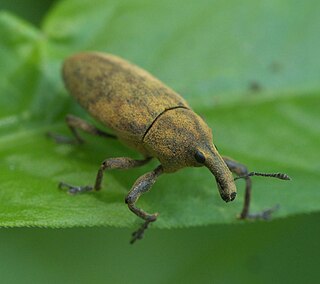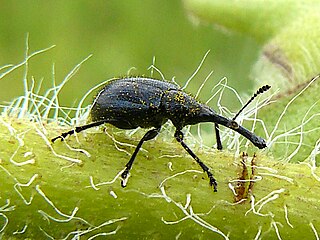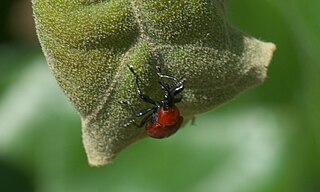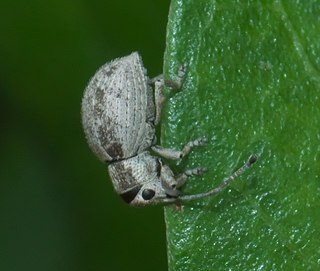
Lixus concavus, commonly called the rhubarb curculio, is a species of weevil. Rhubarb is a host, together with dock, sunflower, and thistle.

Smicronyx fulvus, commonly known as the red sunflower seed weevil, is a weevil in the family Curculionidae.

Hypera postica, commonly known as the alfalfa weevil, is a species of beetle in the superfamily Curculionoidea; it can be found in alfalfa fields throughout Europe. Considered a destructive threat to alfalfa production in North America, several accidental introductions have been successfully countered though the use of a variety of biological control species.
Trichobaris trinotata, commonly known as the "Potato stalk borer", is a species of weevil in the family Curculionidae. It is found in North America where it is a pest of potato plants, the larvae tunnelling inside their stems.

Haplorhynchites aeneus, known generally as the head-clipping weevil or sunflower headclipping weevil, is a species of leaf rolling weevil in the beetle family Attelabidae. It is found in North America.
Rhynchus is a genus of hidden snout weevils in the family of beetles known as Curculionidae. There is at least one described species in Rhynchus, R. apiculatus.
Xyloterinus is a genus of typical bark beetles in the family Curculionidae. This is a monotypic genus and the one described species is Xyloterinus politus. It is native to North America where it infests both hardwood and softwood trees, as well as stacks of logs.

Curculio sayi, the small chestnut weevil, is a species of true weevil in the family of beetles known as Curculionidae. It is found in North America.The distribution of this species extends from Canada and Massachusetts to North Carolina, Tennessee, and Ohio, and probably farther westward. The average length of the body is about 1/4" (6mm).

Homoeolabus analis, known generally as the leaf-rolling weevil or oak leaf rolling weevil, is a species of leaf-rolling weevil in the family of beetles known as Attelabidae. It is found in North America. It is often preyed upon by the obligate egg predator and nest thief Thief Weevil.
Conotrachelus adspersus is a species of true weevil in the beetle family Curculionidae.

Anthonomus aeneolus is a species of true weevil in the beetle family Curculionidae. It is found in North America. It normally develops within the flower buds of Solanum flowers, although eggs can be laid within galls on the plant. Larvae feed on the anthers of the flowers.

Pissodes nemorensis, known generally as the eastern pine weevil or deodar weevil, is a species of true weevil in the beetle family Curculionidae. It is found in North America and Africa. Deodar weevils are considered a forest pest in the United States, with adults and larvae feeding on a variety of coniferous tree species, including trees such as deodar cedar, loblolly pine, longleaf pine, sand pine, shortleaf pine, slash pine, and spruce pine Trees of all ages are susceptible to weevil infestations, while trees that are severely stressed by fire, drought, extreme cold, fusiform rust, wind damage, and other problems are prone to weevil infestation. In well-managed pine stands, deodar weevil infestations are sporadic, attacking only the suppressed and unhealthy trees throughout the area. Because they do not typically effect healthy trees, they do not usually alter traditional management strategies. Unlike many other forest pests in the eastern United States, deodar weevils are most active in the winter months, and this is often when sign of infestations can be seen. The best way to avoid a deodar weevil infestation is to maintain good tree and stand health: healthy trees do not typically face mortality or extensive damage from these pests. If an infestation has occurred, pesticides can be used in the fall as the weevils become active, but are typically not recommended.
Listronotus oregonensis, the carrot weevil, is a species of weevil in the beetle family Curculionidae. It is found in North America.
Peltophorus is a genus of twig and stem weevils in the beetle family Curculionidae. There are at least two described species in Peltophorus.
Cylindrocopturus mediinotus is a species of true weevil in the beetle family Curculionidae. It is found in North America.
Peltophorus polymitus is a species of true weevil in the beetle family Curculionidae. It is found in North America. Both adults and larvae are pests of agave plants, feeding on leaves and needles.
Cylindrocopturus nanulus is a species of true weevil in the beetle family Curculionidae. It is found in North America.

Neoptochus is a genus of oriental broad-nosed weevils in the beetle family Curculionidae. There is at least one described species in Neoptochus, N. adspersus.
Cylindrocopturus mammillatus is a species of true weevil in the beetle family Curculionidae. It is found in North America.
Nealiolus curculionis is a species of parasitic wasp in the family Braconidae. It is a parasitoid of the sunflower stem weevil Cylindrocopturus adspersus, and a number of other species of stem-boring weevils.








